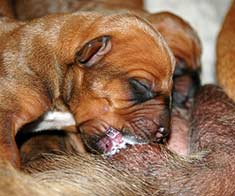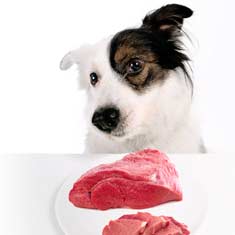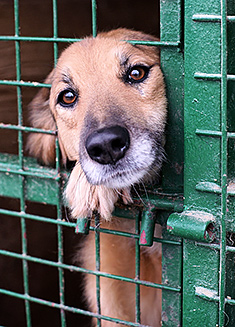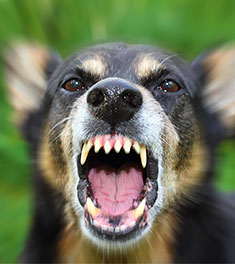Dog Birth
In the third article of our dog pregnancy series, we look at the wonderful, but messy, process of bringing newborn puppies into the world. Earlier articles looked at symptoms of dog pregnancy, and caring for your pregnant dog.
Part I: Dog Pregnancy Symptoms
Part II: Dog Births on the Way
When will my pregnant dog give birth?
You will know your dog is about to present you with newborn puppies when her temperature drops. A normal canine rectal temperature is between 100 and 102 degrees. About 8 – 24 hours before giving birth, the mama dog’s temperature will drop to about 98 degrees. Your dog will enter the first stage of labor, where the cervix begins to dilate, without giving much notice to you. This first stage will produce some mild contractions, and your dog may begin pacing, shivering, and panting. She may seek out a private place. If you see this, guide her to the whelping box, where she may want to squat or lie down for the birth.
Stages of Dog Labor
After 6 – 12 hours of stage one labor, your pregnant dog will go into active labor, where she begins actively straining and pushing to expel the newborn pup. If she strains for more than an hour without producing a puppy, you will need to contact your vet. Normally, active labor lasts just 20 minutes for each puppy. After the puppy comes out, the placenta is expelled. You should remove the placenta from the whelping pen as soon as possible and discard it. The dog may rest for an hour or so, then go into active labor for the next puppy, repeating the cycle until all of her puppies are out.
Most puppies are born either headfirst or butt first. If one of the pups appears to get stuck, you can assist in the dog birth by hooking your index fingers either behind the shoulders or over the hips and gently pulling in a downward motion. Don’t pull on legs or ears to get the puppy out, as you can easily dislocate a joint or pull an ear off.
Taking Care of Newborn Puppies
Once the puppy is free, the mama should be able to care for them herself, but if she doesn’t start cleaning them within 2 minutes of birth, you must step in. The newborn puppy will be covered in an amniotic sac, which must be broken open to allow the pup to breathe. Next, the umbilical cord must be tied and cut off to separate the puppy from the placenta.
Normally, the mother will lick the puppy to break the amniotic sac and will chew off the umbilical cord, but she may become exhausted by labor and not be able to care for the puppies, particularly if it is a large litter. If you must step in, simply break the sac from around the puppy’s head with your finger. You can use an aspirator (technically known as a “snot sucker”) to get the mucus out of the puppy’s nose and mouth. Using a clean towel for each puppy, gently clean out the eyes and massage the area around the umbilical cord to stimulate the puppy to take a breath.
Once you are sure the puppy is breathing, it is time to cut the cord. Tie a strand of dental floss tightly around the cord about an inch away from the puppy’s belly. Tie another strand about Ľ-inch closer to the placenta, then cut it between the knots with clean scissors. Dip the puppy end in betadine or iodine to prevent infection. Now the puppy is ready to meet his mama.

Place the newborn puppy where he can seek the mother’s teats as soon as possible after birth. Mother’s milk provides important antibodies to keep the puppy healthy, and his suckling may encourage the mother to begin active labor again for the next puppy. If you have had X-rays taken, you will know how many puppies to expect, so make sure you monitor your pregnant dog during the delivery until all puppies are birthed.
Count the placentas to make sure there is the same number of placentas as puppies. If the last placenta is not expelled, or if you suspect there are still puppies inside but the dog has stopped active labor for more than 4 hours, contact the vet.
Keeping Records of Your Dog Births
As you can see, there is a bit of work you may need to do, and you will want to keep careful records of the puppies as you go, so you might want to have two people present during the births. Plus, you will need someone to keep you company during the “down” time between births. The second person can weigh the puppies and record the birth order and any identifying characteristics so you can tell them apart later.
One trick some breeders use is to keep a separate pen, warmed by a heating pad placed under several towels. When the dog goes into active labor, remove all of the earlier puppies from the whelping pen to the auxiliary pen until the next puppy is born, cleaned up, weighed, and recorded. Then put all of the puppies back in to nurse until the next active labor begins.
Caring for mama
Once you are sure your puppies have all been born, let the mama have a light meal if she wants it, and allow her outside for a potty break. If she won’t eat, try serving her a bowl of warm condensed milk, mixed with an equal amount of water and two raw egg yolks. Yum!
Mama is likely to produce a bright green or reddish brown discharge for about the next two months, which is normal. However, if the discharge is bright red, you need to call your veterinarian right away. Continue to take your dog’s temperature daily and inspect her mammary glands. Contact your vet if the temperature rises above 103 degrees or if the mammaries become inflamed. Either is a sign of infection that must be treated.
Lactation will make your dog really hungry, so be sure she has access to a high quality food several times a day. Add cottage cheese to her food to provide enough calcium, or see if the vet wants you to give her a calcium supplement. Do NOT put a water dish inside the whelping pen as the puppies may drown in it, but make sure the mama dog can get to a clean water source whenever she wants it.
Now that the puppies are out, your focus will shift to caring for the newborn puppies. Check back here for the fourth article in our series, called Newborn Puppy Care.
Doggies Den: Latest Articles
 Homemade Thanksgiving Treats for Your Dog
Homemade Thanksgiving Treats for Your Dog
NUTRITION We all want to include our dogs in our holiday celebrations, but hopefully, you're aware that sharing table scraps with your dog isn't always the best idea.
 Keeping Your Dog Safe during the Summer Months
Keeping Your Dog Safe during the Summer Months
HEALTH Summer is coming on fast, so it’s time to plan how you will keep your dog safe and healthy through the lazy, carefree, warm days.
 Vaccination Time Again-Keeping Your Puppy Healthy
Vaccination Time Again-Keeping Your Puppy Healthy
DOG HEALTH So you have your new puppy picked out. There are quite a few shots, treatments and examinations that will keep the newest member of your family healthy.
 Canine Thanksgiving Feast
Canine Thanksgiving Feast
NUTRITION With the wide variety of food at Thanksgiving dinner, chances are you'll want to give your dog something special, too. If you're contemplating what to feed your dog for the holiday, here is a guide to a great Canine Thanksgiving Feast.
 Dog Walking Tips Every Owner Should Know
Dog Walking Tips Every Owner Should Know
DOG FUN Walking your dog is not only crucial to keeping him healthy and happy, it strengthens the bond between your canine friend and his caregiver. There are a lot of obstacles out there. Don’t forget these simple tips to keep your walk fun and safe in the outside world.
 The Benefits of Physiotherapy for your Dog
The Benefits of Physiotherapy for your Dog
HEALTH The same techniques that physiotherapists use to treat a variety of injuries and conditions in humans have been adapted to suit animals with great success. Family pets, show dogs, and working dogs can all benefit greatly from physiotherapy. Dogs whose activities involve a lot of agility are especially susceptible to the types of problems that physiotherapy can address.
 The Decision- Adding a Dog to Your Family
The Decision- Adding a Dog to Your Family
FIRST TIME OWNERSBringing a dog into your family is a decision where many people don’t realize it’s magnitude until after they have the dog. There are a number of things that you need to research before you decide to purchase a dog, and it starts right in your own home.
 Bringing Your Dog Into Your New Baby's Life
Bringing Your Dog Into Your New Baby's Life
HEALTH Many believe that a dog and a new baby cannot happily coexist, so therefore the dog has to go. This is not necessarily the case.  A new baby does not mean you have to abandon your dog.

Doggies Den:
Most Popular Articles

Dog Pregnancy Symptoms
HEALTHIf you suspect your dog might be pregnant, check out part one in this series on pregnant dogs, where we cover pregnant dog symptoms.

Dog Birth
HEALTHIn the third article of our dog pregnancy series, we look at the wonderful, but messy, process of bringing newborn puppies into the world.

Indoor Dog Potties
DOG PRODUCTSIt's been a long day at work. You were so busy, you didn't even take time to eat a sandwich, let alone run home to let your dog out. You're on your way home, knowing the poor dog is crossing his or her legs by now, when your car breaks down, delaying you even further. Can't somebody make this easier?

Your Dog’s Digestive System
PHYSIOLOGYEver wonder why your dog eats so fast? Or why he eats gross things? Or why he gets sick to his stomach? Or why his waste stinks so bad? Some of these things are normal, some are not.

Canine Respiratory System
BREATHINGThe basic function of your dog's respiratory system is to bring oxygen in to and remove carbon dioxide from the body. Knowing the symptoms of respiratory diseases can help you help your stay healthy.

Shelter Dog Adoption Tips for Success
ADOPTION Are you intimidated by the prospect of "rescuing" a dog from a shelter? One reason that you may be wary of adopting a dog from a shelter is not knowing how to choose. Adopting a dog from a shelter can be a rewarding process, if you're prepared to do a reasonable amount of research.

Canine Urinary Tract Infections
SYMPTOMS AND TREATMENTDoes your dog seem to be having trouble relieving his or her bladder? Learn how to recognize the signs of urinary tract infections and how to treat them before they spread.

What to do for Dog Diarrhea
SYMPTOMS AND REMEDIESIf you have dogs in your house for any length of time, you have likely experienced at least one bout of dog diarrhea. Beyond the pain in the tuckus involved in cleaning up the mess, you should know what causes diarrhea, and when it's important to see the vet.

What to do for a Dog Bite
DOG BEHAVIOR Getting bitten by a dog can be scary, and you may be tempted to run around in circles for a while, trying to figure out what to do. Here's our guide to help you manage the situation.

Top Ten Tips for Living with a Senior Dog
DOG HEALTH Bringing home a new puppy is so exciting, but it doesn’t take all that long for your exuberant puppy to grow into a senior dog who may have special needs. Here are the doggies.com top ten tips for taking care of your companion who has been with you through so much.
